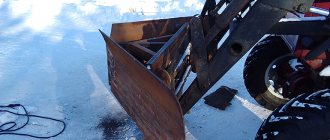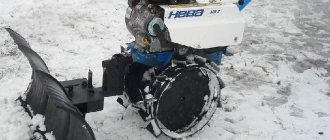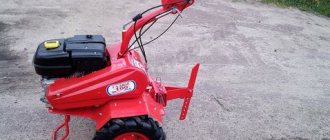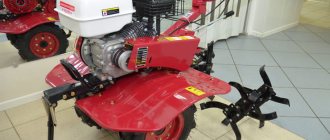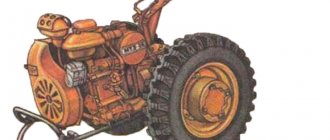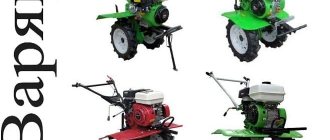With the onset of cold weather, private farm owners are faced with the problem of snow removal. Previously, snow shovels were used for this; nowadays, almost every household has a walk-behind tractor, which can be adapted for these purposes using a special blade. You can buy a shovel blade (blade) in a specialized store (which is quite expensive), or you can make it yourself. By making such equipment yourself, you will save quite a significant amount and will not spend a lot of time.
Description of the blade for the walk-behind tractor
A blade (blade blade, shovel attachment) is a mounted tool in the form of a shovel or bucket, which is mounted on a walk-behind tractor for the purpose of removing snow and debris from a flat surface, and can also be used to level land for planting vegetables or a lawn.
It is a universal equipment, it can be used with any model of walk-behind tractor, without being tied to the power characteristics of the engine. The factory-made blade attachment has the following dimensions: width – 100 cm, height – 40 cm, however, for handicraft production, any dimensions can be selected.
When manufacturing a blade, you need to select such dimensions so that the load on it corresponds to the power of the walk-behind tractor. The use of a tool whose design is designed with too much performance can lead to overload of the unit and its failure.
Preparing for work
You can install a snow blade on the frame of any motorized cultivator with a power of at least 4 liters. With. and weighing more than 50 kg. Also, by reviewing the drawings of a plow for a mini-tractor with your own hands, you can adjust them to your needs if you have a mini-tractor on your farm. It is important for this unit that it is not lightweight. The heavier it is, the easier it will be to clear the snowdrifts. The domestically produced Neva walk-behind tractor is well suited for this type of work. The equipment has a high performance coefficient. The walk-behind tractor is adapted to harsh weather conditions at maximum loads.
In the process of making a shovel for a walk-behind tractor, you will need the following tools:
- Welding
- Roulette
- Grinder with cutting and grinding discs for metal
- Electric drill
- A set of keys
- Screwdriver
- Paint brushes and paint
Having completed the preparation of the tool, you can begin to select the material for making the device. Many metal products with a good strength rating can be suitable for this.
The shovel can be made from such materials
- Inoperative gas cylinder. The walls of the product are made of thick and durable metal, so having made such a dump, it will be possible to remove compacted snow, level the ground, rake crushed stone and sand.
- Large barrel with a capacity of 200 l. When choosing such a material, you need to remember that the steel of the product is not thick, and such material can only withstand removing snow that has recently fallen and is not compacted.
- Metal strips. For manufacturing, truck bumpers or corrugated steel for covering the floor of production facilities may be suitable.
To make a snow dump, you can also use Zykov’s plow, drawings and dimensions. As a material for the rotating mechanism, you need to choose steel with a thickness of more than 10 mm. Such material is easy to find at scrap metal collection sites. For fastening you will need a steel pipe profile of approximately 20x40 mm.
In the process of creating drawings and manufacturing snow removal devices, devices such as a reversible plow for a walk-behind tractor or a horse plow are often used. Their design can be modified and changed depending on the availability of materials and needs.
When working with loose snow and deep hillocks, the equipment can get stuck and slip. This problem is solved by installing tracks on the axle shaft of the tractor. After this, you can work with the snow blower in any conditions without losing productivity.
Why do you need a blade for a walk-behind tractor?
Using a blade you can perform the following basic work:
- clear snow drifts;
- level the surface of the earth;
- remove trash;
- perform loading operations (if the blade is in the form of a bucket).
A walk-behind tractor with such a hitch can also be used for:
- creating landscape design;
- construction of roads and paths;
- quick digging of trenches, wells and ravines;
- creating high beds;
- collecting bulk materials for their subsequent transportation in a cart (trailer);
- spreading soil or organic fertilizers around the site.
As can be seen from the list of works, the dump can be used all year round.
Attaching the blade to the tractor
Most walk-behind tractors are equipped with a standard bracket for attaching attachments. It can be used to attach the front shovel of a tractor. If necessary, you can make an adapter to ensure that the blade turns to the left or to the right. When installing the bucket at the rear of the machine, skimmer mounting technology can be used.
Making the front bucket mount:
- Weld a profile pipe onto the back of the bucket. For reinforcement, it can be bolted after welding.
- Make a semicircle with a radius of 10 - 12 cm from a metal sheet 1 cm thick. The workpiece must be welded to the profile pipe. Holes are drilled in a circle to make it possible to set the angle of rotation of the blade.
- When making a shovel, the holder is also made. To do this, you need to make a “g”-shaped profile from a square pipe. The short side of the holder is attached to the rotary sector, and the other edge is rigidly fixed to the tractor bracket. The height will be adjusted using bolts screwed into the adapter.
There is a simpler method of fastening; for this, eyes and locks made of durable steel sheet are used.
Blade classification
This simple mounted implement has the following classification:
- According to execution form:
- shovel blade (straight rotating, straight non-rotating);
- bucket (hemispherical, spherical, spherical for bulk materials).
- According to the method of attachment to the walk-behind tractor:
- standard bracket;
- using lugs and locks.
- According to the location of the working body relative to the walk-behind tractor
- front;
- rear (if the steering column can be rotated 180 degrees).
- By hitch type:
- adjustable:
- unregulated.
- By type of lifting mechanism:
- manual or mechanical;
- hydraulic.
Basic rules and manufacturing criteria
An important point that cannot be neglected when drawing up a homemade drawing is the ratio of the amount of work to the power of the unit. When overloaded, components and mechanisms will quickly wear out, which leads to breakdowns and inoperability of the machine.
The manufacture of a blade for a walk-behind tractor must meet certain conditions:
- Durable material. For normal service, at least for several years, the knife must have a strong base. Any part of the shovel must be made to withstand loads and strong impacts.
- Exposure of sizes. A homemade blade should not be very wide or high. The optimal width is considered to be from 80 to 130 cm, and the height from 30 to 50 cm.
- Lifting mechanism. When developing a drawing, a lifting device in the form of hydraulics or levers can be added to the design. This function will allow you to transport snow or use the unit as a loader.
- Swivel joint. Using such a device, you can change the angle and inclination of the shovel left and right, up and down. Thanks to this, snow or debris removal will be carried out better and taking into account human needs. To turn up and down, you can make a structure similar to a rotary plow.
- Rubber. It is imperative to install a shock-absorbing strip made of dense rubber on the lower part of the blade. In this case, the walk-behind tractor is less damaged from impacts, and the bucket is less damaged from deformation and failure. The road surface is also protected.
- Speed of installation and dismantling. Since the walk-behind tractor is a universal device, its equipment should be carried out as quickly as possible without the use of special tools.
Read also: IP20 protection for the bathroom
The blade can be placed on the front bracket, under the chassis or behind the walk-behind tractor. For mounting in the rear, you can use the attachment of the plow to the walk-behind tractor, which will greatly facilitate and speed up the work, but placement in front of the unit is considered the most suitable. This installation ensures maximum cleaning quality.
The finished product can be created and oriented in a horizontal or vertical position. The vertical option is chosen when space is cramped.
Blade design features
Structurally, the walk-behind blade is a curved metal surface and consists of the following elements:
- working body (the shovel itself or the bucket);
- fastening unit;
- mechanism for adjusting the angle of rotation of the working body.
As a rule, the shovel attachment is fixed in one of three positions during operation:
- directly;
- with a rotation of 30 degrees. left;
- with a rotation of 30 degrees. to the right.
Before starting work on the manufacture of a blade, carefully analyze the available recommendations and read the literature on this topic.
Some points to pay attention to when creating a blade for a walk-behind tractor
The manufactured product must meet the following criteria:
- Reliability. The strength characteristics of the knife and shovel must be high enough for the device to last as long as possible without repair. For the manufacture of all parts, it is necessary to select such materials, the use of which would ensure the maximum load on the device, but not exceeding the limit values for the power plant of the unit.
- Dimensions. Factory dumps have standard dimensions, but if you make them yourself, you can make them whatever you want. Of course, you want to make the tool as productive as possible, but you shouldn’t go too far beyond the standardized dimensions. This can lead to overload of the motor and damage to the walk-behind tractor.
- Availability of a lifting mechanism. It is needed to expand the possibilities for using the blade, since if it is available, it will be possible not only to clear snow and remove garbage, but also to remove it from the site. Also, the lifting mechanism will be useful, for example, when loading bulk materials onto a cart or moving them around the site. There are only two types of lifts: mechanical (the position of the shovel is changed manually using a lever) and hydraulic (using a hydraulic pump). A mechanical lift is not difficult to implement; a hydraulic lift will take a little more work, but it is also quite simple.
- The presence of a swivel joint. If it is possible to adjust the shovel vertically and horizontally, then snow removal will be more efficient.
- Security. A thick rubber strip on the blade of the blade will protect the device from impacts, breakages and deformations, and the surface being processed from damage.
- Quick installation/dismantling. Sometimes you need to quickly change the attachment to a walk-behind tractor; therefore, it is advisable to provide for this possibility when creating the mounting of the blade to the unit.
The rounded top allows the blade to roll the snow in front of it rather than simply moving the snow mass. Thus, the walk-behind tractor needs to use significantly less force than with a straight shovel.
Snow plow options
Clearing snow and mud is a labor-intensive job, so to make it easier, equipment is widely used: an SUV, an ATV, a walk-behind tractor. There are different options for ready-made snow plow designs on the attachment market. To minimize the cost of purchasing a tool, it is easy to make it yourself.
Snow blowers are divided into three groups.
For SUV
The device can be installed both on a domestic car and on an all-wheel drive foreign car. Convenient when the blade is disassembled. In this case, it can be easily dismantled and placed in the luggage compartment of the car. The snow blower is equipped with an electric winch, which provides control of the tool directly from the SUV's cabin. Depending on the amount and density of precipitation, the shovel is positioned at a certain angle.
Snow blade for "Niva"
For ATVs
The choice of device design for mounting on the frame depends on the vehicle model.
There are the following types of installation equipment:
- Front kit , when the blade is engaged with the front frame, which is typical for cars with low ground clearance.
- The center mounting kit fits into the structure of the ATV frame and at the same time strengthens it. This design maintains high ground clearance and ensures stability during snow removal work.
The width of the shovel depends on the power of the motor, the weight of the equipment and can be from 125 to 150 cm.
Blade for walk-behind tractor
Blade for walk-behind tractor - drawing
Homemade blade shovels for a walk-behind tractor do not need to be equipped with a spring damping mechanism to protect them from contact with an uneven surface, since the walk-behind tractor has a low speed of movement. In addition, you can eliminate the need for a lift-and-turn device, which significantly reduces the cost of a working snow removal kit.
Snow removal with a walk-behind tractor is productive due to the fact that the device not only occupies a forward position, but also rotates left and right at an angle of 300. The working width depends on the model of the lifting and rotating bucket. If metal with a thickness of 3 mm is used, the standard value is one meter.
When equipping a walk-behind tractor with snow removal equipment, it is important to purchase metal lugs. They make snow removal easier and improve its quality.
Required tools and materials
In order to make a blade for a walk-behind tractor with your own hands, you will need:
Materials:
- To create a working surface, a 200-liter steel barrel, an empty gas cylinder or a sheet of iron is suitable;
- iron piece 5 mm thick;
- a piece of pipe with a square cross-section of 40x40 mm and a length of 1 m;
- a strip of thick durable rubber;
- sheet steel 10-12 mm thick;
- fasteners (bolts, nuts).
Tools:
- roulette;
- welding machine;
- angle grinder (grinder);
- drill with a set of drills;
- a set of wrenches, a hammer, pliers and other plumbing tools.
What is this design?
Snow clearing equipment can be installed on any agricultural machinery, including walk-behind tractors. The use of these devices will make life much easier for the owner of a private home, since with their help it is much easier to get rid of drifts than manually.
The blade on the walk-behind tractor consists of several parts: a knife, a mechanism for adjusting the angle of rotation, fasteners and a lock on the chassis. There are many options for factory dumps, but their cost is quite high. For this reason, owners use drawings to help them assemble the attachment themselves.
There are several design options that allow you to perform work in different areas. The blade must be strong enough so that it can not only remove dense snow, but also level areas, rake debris and perform other work at different times of the year. The advantage of using dumps is that all work will be completed as quickly and efficiently as possible.
Features of making a blade for a walk-behind tractor with your own hands step by step
The blade can be made in different ways from different materials. Let's consider the 2 most popular:
- from a steel 200-liter barrel;
- from a gas cylinder;
Drawings with dimensions
- Blade
- Left knife
- Medium knife
- Bolt
- Washer 16.65G.019 GOST 6402-70
- Nut M16-6N.5.019 (S24) GOST 15523-70
- Bolt
- Right knife
- Washer 20.65G.019 GOST 6402-70
- Nut M20-6N.8.019 (S30) GOST 15523-70
Blade from a barrel
Let's take a step-by-step look at how to make a shovel for a walk-behind tractor using a metal barrel:
- Take an old 200 liter barrel and cut off the lid and bottom with a grinder.
- Apply markings to the barrel so that you get 3 identical sectors of 120 grams each. After that, cut it with a grinder.
- Connect the two segments at their ends with an overlap of 3 cm using a welding machine. Next, you need to strengthen the structure. To do this, cut the remaining part of the barrel into strips with a grinder. Attach one strip to the sides of the shovel, distribute the rest evenly along the entire length of the working body. You can also use a profile pipe.
- To protect the working surface of the blade, a knife is installed in its lower part. To do this, you will need a metal strip the same length as the grip of the shovel, 100 mm wide and 5 mm thick. Using an electric drill, make holes in the knife with a diameter of 5-6 mm at intervals of 100-120 mm for mounting the rubber strip.
- Place the rubber strip on the knife. It is better to make the width of the protruding part from 3 to 10 cm. The tape should be removable so that the blade can be used for working with bulk materials.
- Next, we attach the shovel to the walk-behind tractor. Make a U-shaped part from sheet iron (you can take a suitable channel).
- Make several holes in the resulting U-shaped part to set the required angles of rotation of the shovel. We also make holes for attaching a square metal profile.
- Weld the resulting part in the center of the work surface.
- Now you need to make an adapter. Take another piece of square pipe and make an L-shaped part from it. The short side of this adapter is attached to the U-shaped part, and the other end of the pipe is bolted to the walk-behind tractor frame.
- To adjust the height of the blade, weld two eyes to the lower profile (which is connected to the rotary sector) and a metal plate to the upper one (which is fixed to the walk-behind tractor bracket). Make a hole in the plate for the bolt. Take a piece of pipe and drill a hole. One end of this pipe will be bolted to the down pipe, and a bolt or threaded rod will be welded to the other end. Thread the bolt into the hole in the metal plate to make a handle.
- A shovel for a walk-behind tractor for clearing snow with your own hands is ready.
It should be taken into account that the thickness of the barrel walls is small. It is better to use such a blade for cleaning recently fallen snow, which has not yet compacted and is not covered with an ice crust.
Blade from a gas cylinder
Using a cylinder, a motorized cultivator-snow blower is made in the same way as from a barrel with minor differences. Assembly order:
- Release excess pressure from the cylinder.
- Cut off the caps from the ends of the cylinder so that the width of the resulting pipe is 1 m.
- Cut this pipe lengthwise into two equal parts.
- By welding, fasten the 2 parts so that the height of the blade is about 700 mm.
- Make a hitch.
Since the walls of the cylinder are quite strong (thick), their additional strengthening is not required. With such a blade, the walk-behind tractor will be able to work with compacted snow, level the surface, move sand and crushed stone without fear of damaging the working surface of the shovel.
Instructions for making a homemade grader
We will give an example of how a shovel is made in the simplest way - a blade for a walk-behind tractor. You do not need to purchase large metal sheets for it, this is the main advantage of this method.
Three types of blade can be cut from a barrel: standard, with a small working width, or, conversely, extended. This will allow you to use the walk-behind tractor both for cleaning narrow paths and for leveling spacious areas. The good thing about the barrel is that it already has the ready-made roundness that a grader should have. You will get rid of the need to heat up the metal sheet and bend it.
- Use a grinder to cut off the bottom and lid of the barrel. Divide it into three equal parts. Two of them will become a dump; to do this, you need to connect them along the contour by welding. The remaining segment is cut into several strips, which will become the stiffening ribs of the future shovel. Two strips are installed on the sides, and several pieces are welded along the entire length of the grader;
- The next step will be to equip the lower part with a special knife. To do this, take a pre-cut strip of 85x10x0.3 cm and make three holes in it with a diameter of about 6 millimeters. Between them you need to maintain gaps of about 10-12 centimeters. These holes will be needed to install the gasket. It will serve as a sheet of rubber. It will be needed to prevent damage to the sidewalk. The knife is attached to the working part of the bucket using bolts;
- Assemble the structure;
- Now you need to assemble the attachment point for the grader to the walk-behind tractor. A piece of iron pipe is attached to the central part of the bucket. A semicircle with several holes is mounted on it using welding, which will help you fix the attachments in the desired position. The semicircle is cut out of a thick sheet of metal, since it will have to withstand severe loads;
- First, shape another piece of pipe with a square cross-section into the shape of the letter “L”. To do this, the pipe is slightly heated and then bent. This is the most difficult stage of the work; you won’t need to put in any more effort;
- Place the short part of the holder in a semicircle, and fasten the long part with bolts to the cultivator motor frame. The height of the equipment is adjusted using two bolts that will help you raise or lower the blade blade.
Important! Before installing the grader on the walk-behind tractor, treat it with a special primer or paint. This will greatly increase its service life, since the painting will resist corrosion.
A rubber gasket is installed on the working edge of the blade, which should be slightly wider than the knife. In this case, you will be absolutely sure that when turning or changing the angle of the bucket, the paving stones or decking in the yard will not be damaged.
Rules for using a homemade blade
Follow these rules and your equipment will last longer:
- To save the resource of the power plant, use the blade only if it is necessary to remove snow more than 5 cm high. In other cases, it is better to use a sweeping brush or scraper.
- When working with a blade, it is advisable to equip the wheels with tracks or other devices that increase the traction of the walk-behind tractor with the surface.
- Periodically check the motor of the walk-behind tractor - when working with mounted implements, it is subject to increased load and wear.
- Regularly check the reliability of the fasteners; if any defects appear, replace them immediately.
- To prevent deformation and breakage of the blade, before starting work, carefully set the height of its position;
- Use protective equipment, both for yourself and for your equipment. For example, steel guards can be used to protect the unit.
- Carry out regular maintenance of the walk-behind tractor and additional attachments (the frequency is indicated in the instructions for use).
- At the end of the winter season, before storing the blade for long-term storage, thoroughly clean it of any remaining snow and dry it. After this, treat all elements with anti-rust agent, and lubricate the rotating mechanisms with oil or grease.
It is important to take care of the condition of the metal surface. It is best to periodically treat it with special chemical solutions that prevent the formation of rust and subsequent destruction of the metal. The surface of the dump can be coated with frost-resistant paint.
Thus, when making a blade for a walk-behind tractor with your own hands from available materials, it is recommended to adhere to the rules and recommendations for its creation. For anyone who decides to assemble a homemade product, it will be easy to determine the dimensions and mount the device to suit their needs and a specific walk-behind tractor model. With such a device, snow removal will turn from hard manual labor into a pleasant pastime.
Differences between other grader modifications
If you want to make attachments from steel sheets, then you should take options at least 3 millimeters thick. You should not purchase thicker steel, as it will be very difficult to shape. To ensure rigidity, make the racks from stronger steel; narrow strips will be easy to bend.
Read also: Basic elements of a twist drill
Holes are made in these racks that will help you secure attachments to the walk-behind tractor. In total, this design has 4 parts: a pair of rods, a working surface, brackets and rods. A knife made of a steel plate is mounted on a shovel using bolts. A steel grader must have at least 4 stiffeners installed. Brackets are mounted on the frame of the motor power unit.
The rods are mounted on the blade and brackets. When not in use, it is necessary to lower the working blade to remove the load from the frame of the cultivator's power unit. The rotating mechanism of this grader is manufactured according to the same principle as in the version described above.
Purchasing ready-made attachments can make a big hole in your budget, so you should pay attention to the above instructions for making it yourself. Having a gas cylinder or an old barrel on hand, you can make this design yourself.
The work usually takes no more than three hours. Additional materials for making a grader will cost you much less than a blade made in a factory. Using a walk-behind tractor to clear snow from areas is quite simple: set the shovel at an angle of 30 degrees and lower it.
A self-made grader will cope perfectly with the snow mass. Users note that it is easy for them to level sites for construction, laying paving slabs or equipping beds.
With the onset of severe winter, snow removal becomes a problem. This especially affects owners of private houses and land outside the city. Therefore, many people wonder how to make a blade for a walk-behind tractor with their own hands.
Of course, there is a wide variety of such tools in special stores, but not everyone can afford to buy a device from factory manufacturers, since such a blade for a walk-behind tractor costs a lot of money. If you show creative skills, you can save money and make such a device yourself, especially since you can easily find drawings of a shovel for a walk-behind tractor with your own hands on the Internet.
Instructions for making a homemade grader
We will give an example of how a shovel is made in the simplest way - a blade for a walk-behind tractor. You do not need to purchase large metal sheets for it, this is the main advantage of this method.
Three types of blade can be cut from a barrel: standard, with a small working width, or, conversely, extended. This will allow you to use the walk-behind tractor both for cleaning narrow paths and for leveling spacious areas. The good thing about the barrel is that it already has the ready-made roundness that a grader should have. You will get rid of the need to heat up the metal sheet and bend it.
- Use a grinder to cut off the bottom and lid of the barrel. Divide it into three equal parts. Two of them will become a dump; to do this, you need to connect them along the contour by welding. The remaining segment is cut into several strips, which will become the stiffening ribs of the future shovel. Two strips are installed on the sides, and several pieces are welded along the entire length of the grader;
- The next step will be to equip the lower part with a special knife. To do this, take a pre-cut strip of 85x10x0.3 cm and make three holes in it with a diameter of about 6 millimeters. Between them you need to maintain gaps of about 10-12 centimeters. These holes will be needed to install the gasket. It will serve as a sheet of rubber. It will be needed to prevent damage to the sidewalk. The knife is attached to the working part of the bucket using bolts;
- Assemble the structure;
- Now you need to assemble the attachment point for the grader to the walk-behind tractor. A piece of iron pipe is attached to the central part of the bucket. A semicircle with several holes is mounted on it using welding, which will help you fix the attachments in the desired position. The semicircle is cut out of a thick sheet of metal, since it will have to withstand severe loads;
- First, shape another piece of pipe with a square cross-section into the shape of the letter “L”. To do this, the pipe is slightly heated and then bent. This is the most difficult stage of the work; you won’t need to put in any more effort;
- Place the short part of the holder in a semicircle, and fasten the long part with bolts to the cultivator motor frame. The height of the equipment is adjusted using two bolts that will help you raise or lower the blade blade.
Important! Before installing the grader on the walk-behind tractor, treat it with a special primer or paint. This will greatly increase its service life, since the painting will resist corrosion.
A rubber gasket is installed on the working edge of the blade, which should be slightly wider than the knife. In this case, you will be absolutely sure that when turning or changing the angle of the bucket, the paving stones or decking in the yard will not be damaged.
What is this design?
Snow clearing equipment can be installed on any agricultural machinery, including walk-behind tractors. The use of these devices will make life much easier for the owner of a private home, since with their help it is much easier to get rid of drifts than manually.
Read also: DIY 12V rectifier
The blade on the walk-behind tractor consists of several parts: a knife, a mechanism for adjusting the angle of rotation, fasteners and a lock on the chassis. There are many options for factory dumps, but their cost is quite high. For this reason, owners use drawings to help them assemble the attachment themselves.
There are several design options that allow you to perform work in different areas. The blade must be strong enough so that it can not only remove dense snow, but also level areas, rake debris and perform other work at different times of the year. The advantage of using dumps is that all work will be completed as quickly and efficiently as possible.


